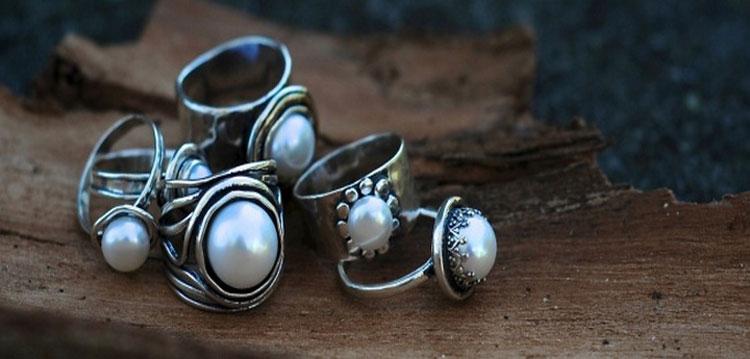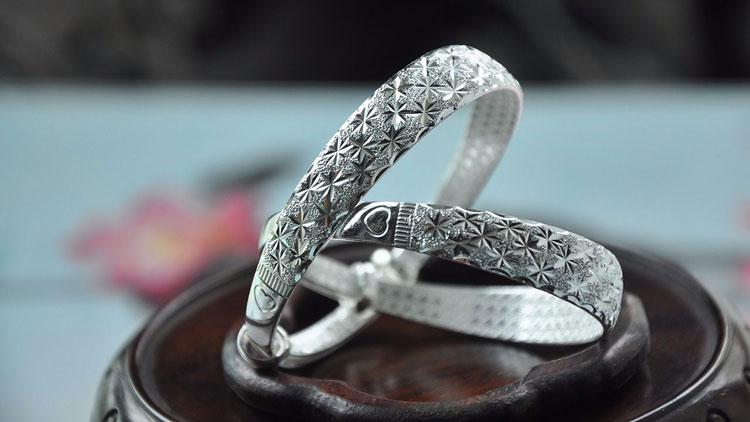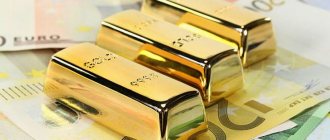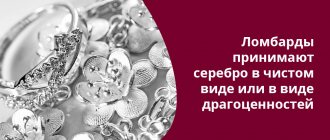Main characteristics and properties of silver
Pure silver is a silver-colored precious metal with a white tint. It has high electrical and thermal conductivity. Among other metals it stands out for its ductility. It can be subjected to any type of processing (twisting, cutting, polishing, etc.) without destroying the structure.
When interacting with oxygen, it showed a complete lack of oxidation, which is why it was included in the list of precious metals.
However, silver also has negative properties:
- Hydrogen sulfide and iodine contained in liquids react with the metal, and the surface of the latter darkens or a “rainbow” film appears on it.
- Pure argentum has a limited service life, which is why it is usually used together with copper and other impurities in the form of an alloy.
Impurities in silver alloys
Pure silver does not hold the required shape well. To impart the necessary properties, the metal is subject to an alloying process. The following elements are used as additives:
- Copper. The most popular impurity in the alloy is argentum, which gives the product a yellowish tint.
- Platinum. It increases the lifespan of jewelry, but is rarely used due to its high cost.
- Nickel. Rarely used due to health hazards.
- Gold. When alloyed with silver and other impurities it produces white gold.
- Cadmium. It is used only by special order from the client due to its high cost.
Table of alloys (samples)
Depending on the composition of the alloy and the amount of pure argentum in it, the product is marked with a certain grade. Its dependence on the ligature is controlled by the state and is specified in GOST R 51152-98 in the form of a table presented below.
| Try | Compound, % | Impurities, no more, % | |||||
| Silver (Ag) | Copper (Cu) | Lead (Pb) | Iron (Fe) | Antimony (Sb) | Bismuth (Bi) | Oxygen (O) | |
| 800 | 80,0-80,5 | ost. | 0,005 | 0,13 | 0,002 | 0,002 | 0,01 |
| 830 | 83,0-83,5 | ||||||
| 875 | 87,5-88,0 | 0,004 | 0,10 | ||||
| 925 | 92,5-93,0 | ||||||
| 960 | 96,0-96,5 | 0,08 | |||||
Brass or nickel-plated cup holders Choose
For lovers of traditional tea drinking and collectors, a glass holder is of great importance. This attribute has become a wide field for the activities of folk craftsmen and a kind of historical carrier of alternating eras. Starting from pre-revolutionary Russia to the present day, it is possible to build a whole chronicle of significant events reflected in the minting, engraving and casting on glass holders of different times.
Coasters with handles for glasses made of precious metals were mainly made to order and belonged to noble dynasties. Brass cup holders, which appeared earlier than others, became more affordable products. Durable and flexible material, resistant to corrosion, in the hands of experienced craftsmen turned into a real work of art. Somewhat later, the development of technology made it possible to produce stands made of stainless steel with a protective and at the same time decorative nickel coating. Nickel-plated cup holders symbolized the Soviet era, although brass continued to be a popular material and was also embodied in propaganda forms.
Brass or nickel plated cup holders – which is better?
Brass and brass cup holders
At that time, brass was obtained by alloying copper and zinc ore, given that zinc was discovered only in the 16th century. ad. The first brass contained a lot of foreign impurities, but its strength and external similarity to gold aroused interest. In 116-117, during the time of Augustus, the alloy was used by the Romans, minting coins from it. Because of its golden sparkle, the metal was named orichalcum, which literally meant golden copper.
The metal that we are used to seeing was obtained only in 1781 by the British scientist James Emerson. Currently, more than 60 grades are produced and used in industry, each of which differs in the composition of alloying substances and properties.
Brass L 63 has the greatest artistic value. Along with its high ductility, flexibility to cold working by pressure, rolling and embossing, this brand is highly polished, acquiring a luster that is visually indistinguishable from gold.
The only drawback is the gradual oxidation of the surface, so over time the material darkens and acquires a greenish tint. But the original appearance of a brass product is easily restored with the help of re-polishing.
Brass coasters have a wider historical range. In addition, you can buy a rare brass glass holder belonging to an earlier period in various themes and shapes.
Nickel and nickel plated cup holders
The first samples of nickel were obtained in 1751 by the Swedish mineralogist Kronstedt. Long before this, Saxon miners, while mining copper, often encountered ore similar to copper, but all attempts to smelt the metal from it failed. For a long time, red nickel pyrite was used only for coloring glass by local glassmakers.
The properties of nickel resemble iron, but its ductility and white silver color immediately attracted attention. In addition, due to the tendency of the metal to naturally passivate, the shine was maintained and did not darken over time.
The metal also turned out to be susceptible to polishing, acquiring a mirror-like surface, which added artistic value to it. Today, nickel is widely used in many modern industries. The element is most in demand as an alloying component in the production of stainless steels. Approximately 7% of the nickel produced is used to coat other metals (nickel plating).
Nickel-plated cup holders have a steel base, so they are more practical and durable. Moreover, the appearance of the products is almost timeless. Perhaps nickel plated cup holders are not as antique as brass ones. However, these tea attributes have high historical value and have the exceptional ability to momentarily return to a time when dreams seemed reality and all roads were open.
Types of silver
It is generally accepted that silver should be white. In fact, there are many more shades of this metal.
Rhodinated
When rhodium plating, the product is coated with a thin layer of rhodium. It is a metal with characteristics similar to platinum. As a result, the jewelry receives protection from darkening, abrasions and scratches, and its natural shine is enhanced many times over.

Among the disadvantages of this method is the loss of the antibacterial properties of the precious metal. In addition, the shade becomes too unnatural, which is viewed negatively by most lovers of silver jewelry.
Blackened
Blackened jewelry is deliberately aged to give the desired shade. As a result, the simplest product looks like an antique. To achieve the desired effect, oxidation is used - coating the surface with a film of silver oxide. One of the advantages of this method is that the alloy retains its proportions and corresponds to the declared sample.

Other
Filigree. This term characterizes silver products of fine openwork design that form lace. To do this, the alloy is drawn into thin wires, from which the desired pattern is subsequently woven. Subsequently, it is placed in a frame or soldered onto a base.

Matte. When solidified, a standard silver alloy forms micro-roughness. By treating the product with a liquid suspension of chemically active ingredients, they can be removed. As a result, the decoration acquires an unusual matte shade.
Gilded. The product is based on a pure alloy (925 standard) and is coated with the thinnest layer of gold of at least 585 standard. Thanks to this method, it is possible to reduce the cost and weight of jewelry compared to similar ones made of gold alloy 585 and higher.
Best answers
Vladimir Chudentsov:
Actually, faucets are not made from chrome. They are only coated with a thin layer of chrome. And the faucets themselves are made of brass (an alloy) or copper (now very rare). So if they tell you that the faucet is entirely made of chrome, then most likely they are deceiving you. It would be fragile and obscenely expensive.
SEVER velloris:
to be precise, the only coating from LS59 is chrome
Evgeny Levichev:
A normal manufacturer is made from brass without using the powder method (there is such a thing) And especially cunning, narrow-eyed manufacturers are made from silumin (and for weight they manage to stuff steel in there so that it weighs like brass), and of course chrome is a must as a coating.
Imitation silver
Imitations are used legally as opposed to precious metal counterfeits. The most popular imitation became cupronickel and nickel silver.
Cupronickel is an alloy based on nickel and copper with the possible addition of manganese and iron. It was widely used primarily for the manufacture of cutlery until the harmful effects of nickel on the body were determined.
Nickel silver is one of the varieties of cupronickel, to which zinc is added. The result is an alloy with a satisfactory cost price.
However, when using it in the form of cutlery, it is necessary to cover each product with a layer of natural silver. Otherwise, the food will acquire a metallic taste.

Great Encyclopedia of Oil and Gas
Nickel brass
Nickel brass has increased mechanical (st up to 785 MPa) and corrosion properties, and is processed by pressure in a cold and hot state. Brass LN65 - 5 is used for the manufacture of manometric and condenser tubes, various types of rolled products.
Nickel brass is brass containing nickel as an alloying component.
Nickel brass has good corrosion resistance, increased mechanical properties and abrasion resistance, and can be easily processed under hot and cold pressure. Nickel brass is used for the manufacture of condenser tubes for marine vessels, pressure tubes, paper machine screens and other products. Under the influence of nickel, the corrosion resistance of brasses in atmospheric conditions, sea water and bacteriological corrosion increases, and the susceptibility to corrosion cracking sharply decreases.
Nickel brass is brass containing nickel as an alloying component.
The corrosion resistance of nickel brasses can be increased by preliminary passivation by immersion in 50% nitric acid.
Nickel (see Nickel brass) increases the corrosion resistance of brass in atm. Standard brass LN65 - 5 is produced, characterized by high corrosion resistance and increased mechanical strength. Sheets, strips, tapes, pipes, rods and profiles are made from brass LN65 - 5. It is used for condenser pipes, manometric.
Nickel (see Nickel brass) increases the corrosion resistance of brass in atm. Standard brass LN65 - 5 is produced, characterized by high corrosion resistance and increased mechanical strength. Sheets, strips, mites, pipes, rods and profiles are made from brass LN65 - 5. It is used for condenser tubes, mapo-metric.
In chemical engineering, nickel brasses are also used, containing up to 12 - 14% nickel, 26 - 30% zinc and 56 - 62% copper. Eggs of brass have increased corrosion resistance in alkaline salt solutions, sea water and acids that do not have oxidizing properties. The corrosion resistance of nickel brasses can be increased by briefly treating them in a 50% solution of nitric acid.
Of the special brasses, nickel brasses should be noted, having the composition: 12 - 14% Ni, 26 - 30% Zn and 56 - 62% Cu.
Of the special brasses, nickel brasses should be noted, having the composition: 12 - 14% Ni, 26 - 30% Zn and 56 - 62% Cu.
LMTs 58 - 2, nickel brass type LN65 - 5, tin brass type LO60 - 1, beryllium bronze type Br.
Of the special brasses that have found application in chemical engineering, nickel brasses should be noted, having the composition: 12 - 14% Ni, 26 - 30% Zn and 56 - 62% Cu. These brasses belong to triple a-solutions; they have high resistance to corrosion in solutions of salts and alkalis and are much more resistant than bronzes in acids that are not oxidizing agents.
Aluminum, brass, Silicon brass, Manganese brass, Marine brass, Nickel brass, Lead brass, Muntz metal. Semi-finished products are made from them in the form of sheets, moulds, strips, pipes, rods and wires.
How to determine a sample by density
To determine the sample of a silver product by its density, you need to prepare a scale and a container filled to the brim with water. First, you need to weigh the jewelry and record the result.
Then it is transferred to a container with water and the volume of displaced liquid is determined. When dividing the mass of the product by the volume of water, the density of the decoration is obtained. You just need to compare the result with the sample table.
How to spot a fake
In Russian jewelry stores, counterfeit silver jewelry is practically never found. However, you can easily stumble upon them when shopping at a fair, market or sales.
To avoid becoming a victim of deception and the owner of an item of dubious quality, you can use a few simple rules.
- If you have a small piece of white chalk, you need to run it over the surface of the product. Contact with silver will cause the chalk to turn black, while counterfeit will have no effect on it.
- To determine the quality of the alloy, you can run a pin across it. If there is no silver in its composition, the resulting strip will be black or red.
The rules described above are highly likely to determine the correct result, but in practice they are of little use, as they damage the surface of the product. This is why other methods are more common when purchasing.
- Hold the product in your fist. If within 1-2 minutes it warms up to body temperature, this is a real precious metal; if it remains cold, it is a fake.
- Press the magnet onto the decoration. Silver will not react to it in any way, unlike iron that imitates it.



